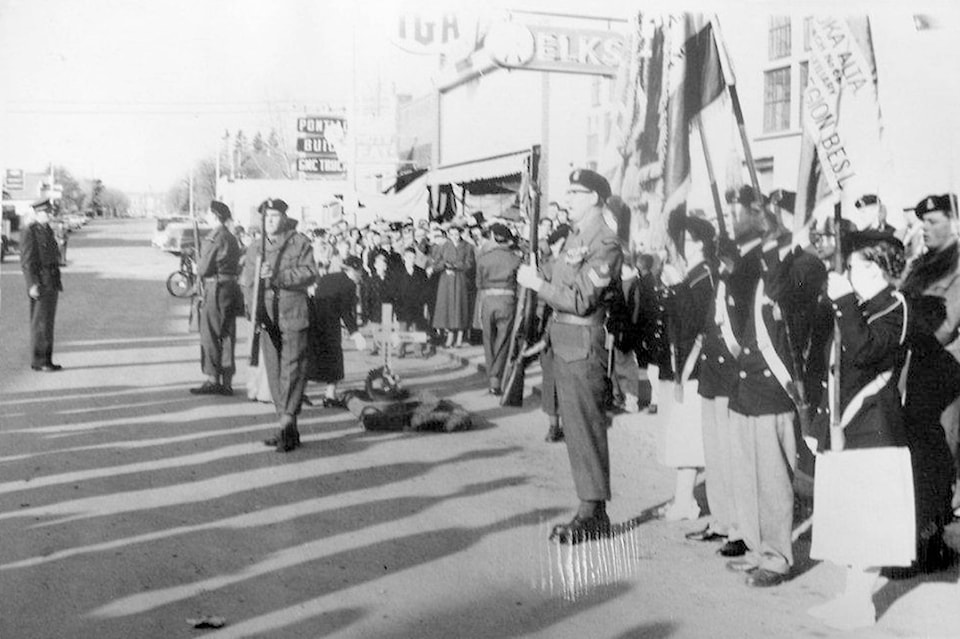By Mike Rainone for the News
As a young lad growing up in and around Ponoka I fondly remember when no matter what the weather might be our parents would bundle up my brother Peter and I and take us to the solemn and traditional Remembrance Day ceremonies at the 46 Ave. cenotaph and the Royal Canadian Legion Branch No. 66. In the 1940s our tiny mother was working in an armament factory in the outskirts of London, England while my father served in the British Army Medical Corp during WWII. When we moved to this community in 1948 he would join the local Ponoka Legion Branch and always looked forward to taking part in some of the countless activities honouring and supporting the men and women serving in the Canadian Armed Forces as the well the veterans and their families.
Later when I joined the local Air Cadet Squadron No. 65 we would always have the honour of marching in the colourful 11 a.m. Nov. 11, Remembrance Day ceremonies along with the Ponoka Town Band, the Pipers, the Royal Canadian Mounted Police, the Legion Branch No. 66 and Ladies Auxiliary Honour Guard, as well as countless special guests, dignitaries, and citizens of all ages. Following the laying of the wreaths and presentations at the cenotaph everyone always looked forward to gathering at the 52 Ave. Legion Hall for fellowship, friendship, and socializing, while casually browsing through the club rooms and viewing the countless photographs, honour rolls, and vivid artifacts and memories of the hundreds of Ponoka town and county residents who have bravely served in our Canadian Armed Forces over a span of a 100 years! Our Ponoka Legion Branch #66 later moved to the present location at 3911-Hwy. 2A location, where hundreds of longstanding and new members of the Branch No. 66 and Legion Ladies Auxiliary have faithfully continued to host their year round community events and traditions since their charter was set in 1928.
The 2019 Remembrance Day ceremony is set for Monday, Nov. 11, with the procession forming at 10:15 a.m. at the Atco Building along Hwy. 2A and then beginning the march to the Legion cenotaph at 10:45 a.m. Following the wreath laying and ceremonies everyone is invited to gather in the Legion for a light lunch and social time. As has become a community tradition in Ponoka for many years if you drive slowly along Hwy. 2A you will see the 128 “Flags of Remembrance,” which are installed by volunteers at the Centennial Park in recognition of the 128,000 members of our Canadian military and RCMP officers who have given the supreme sacrifice or are listed as missing in action since the beginning of the rugged war years.
Armistice Day
The long-standing Canadian tradition of the celebration of Armistice and Remembrance Day marks the date and time when the massive armies locked in battle during WWI would put down their weapons and stopped fighting on Nov. 11, 1918 at the 11th hour. There have of course been other wars and confrontations throughout the decades, during which some 100,000 brave Canadians would lose their lives in the service of the nation.
Each November the bright red poppies bloom on the lapels and collars of millions of Canadians in honour of our fallen soldiers and veterans. The significance of the poppy can be traced all the way back to the Napoleonic Wars in the 19th century, where thick masses of the flower grew over the graves of soldiers in the area of Flanders, France. The person who initially introduced the poppy to Canada and the commonwealth was Lt.-Col. John McCrae of Guelph, Ont., who was a medical officer during the WWI. It was this gentleman who penned the cherished and now traditional poem “In Flanders Fields” on a scrap of paper in 1915 on the day following the death of a fellow soldier. Since 1921 when the poppy was officially adopted by the Great War Veterans Association in Canada as its Flower of Remembrance it has been proudly worn each November during the Remembrance period to honour Canada’s fallen soldiers. As our dedicated Legion members and volunteers throughout our great Nation vigorously conduct their annual poppy campaigns for this very memorial Remembrance each and every citizen can join in by purchasing a poppy or a wreath and attending the Nov. 11 ceremonies to honour the supreme efforts and sacrifice of these brave men and women. Lest We Forget, I found this poem written in 1943 by early Ponoka district pioneer and poet D.A. Morrow which salutes this very special and memorial occasion.
Oh Soldier Boy
The night you said goodbye to me we stood on yonder hill, and listened to that haunting cry, the song of the whip-poor-will.
When’ere I hear that sweet love call your own dear face I see, and could you hear the whip-poor-will you would remember me.
Chorus: Oh soldier boy, my soldier boy, wherever you may be, I pray that God will guard you, and bring you back to me.
I know not where you are tonight … perhaps on desert sands, perhaps you sleep ‘neath northern light in some far distant land.
It matters not where’er you are, in air or land or sea, Oh soldier boy, my soldier boy, you will return to me.
And when at last there comes that day when war and strife will cease, when you have won the victory, and the entire world is at peace … within each other’s arms at last, we’ll stand on yonder hill, and once again we’ll listen to the song of the whip-poor-will!
